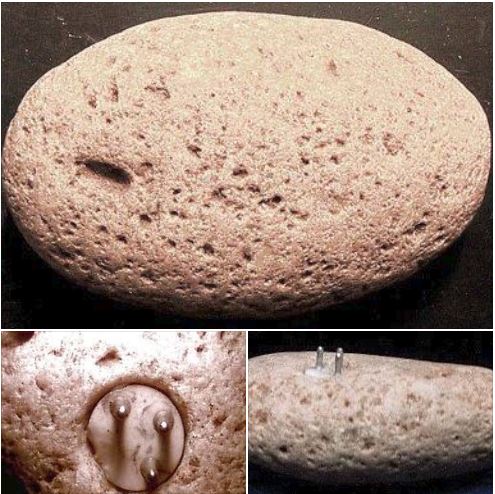Enigmalith the 100,000-Year-Old Alien Plug
It is one of the artifacts that a few have heard of, yet its characteristics are incredibly interesting. There have been dozens of objects discovered through the years that do not fit into the mainstream view of history, archaeology, and anthropology.
This discovery was made in 1998 when electrical engineer John. J. Williams found what appeared to be an electrical connector protruding from the ground on a hiking trip in North America.
The object was found in the middle of nowhere, far away from human settlements, industrial complexes, airports, factories, and electronic or nuclear plants. After digging further into the ground, Williams discovered a device with a triple plug, embedded into the rock.
Williams refused to give away the exact location where the object was found, which has led skeptics to conclude that this artifact is just another hoax. But is it?
Today the artifact is referred to as the Petradox, a device that has the undeniable aspect of an electrical component which ended up embedded into solid granite, stone composed of quartz and feldspar, with small traces of mica. There is a huge amount of secrecy surrounding the object.
Williams has received offers up to 500,000 dollars for the device but has refused to sell it. Williams stated that the artifact, however, is available to any researchers for analysis. So far, only a few individuals have taken the time to study the mysterious object, resembling without a doubt, an electrical component.
The Petradox is not an accretion, concretion, pumice or fossil. It does not contain any known resins, cement, glues, adhesives, limestone, mortar, or other non-rhyolite / non-granite binding agents. It is very hard.

The component itself is about 8 mm in diameter; the pins of the device are about 3 mm high, and the spacing between the pins is approximately 2.5 mm while the pin thickness is about 1 mm.
According to Williams, who has consulted an engineer and geologist to examine the object, the electronic component embedded in the granite reveals no trace of having been glued or welded in any known form, it is clear that the object already existed at the time of the formation of the rock.
According to geological analysis, researchers believe that the “rock” is at least 100,000 years old, something impossible if you believe that the object is of artificial origin.
The conventional understanding of the technological development of mankind tells us that there is no way humans could have made something like this at that time in history.
The device has been compared by some researchers to an electronic XLR connector or similar component. The artifact has a weak magnetic attraction, Ohmmeter readings indicate either open-circuit or very high impedance between the pins.
The artifact does not seem to be made out of wood, plastic, metal, rubber, or any other recognizable material. Williams has not allowed the object to be broken in half for analysis but X-ray tests have shown that the artifact has a mysterious “opaque internal structure” in the center of the stone.
According to Williams, melted blobs of a metallic-like material on the component’s periphery indicate that some metal object near the Petradox was subjected to such high temperatures to cause metal melting and molten metal splashing or sputtering onto the embedded component.
Skeptics firmly believe that this 100,000-year-old electrical component is a manufactured hoax, but Williams does not agree.
He is convinced that he has found a genuine artifact that belonged to an advanced ancient civilization or an extraterrestrial race. Williams is willing to let researchers authenticate the artifact under certain conditions: that he is present during the analysis and that the rock remains unharmed.
There are some of us who believe that science does not have an interest in these objects because they are afraid of what they might find out. The artifact has two possibilities.
While scientific analysis could confirm it as being an elaborate hoax, it could also radically change our understanding of the history of mankind and change the way we look at history and our origins.





